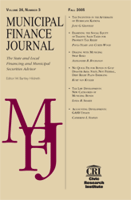Student Housing: Finding the Silver Lining
Author: Matt Whoriskey.; James E. Wilhelm III.; Jeffrey Turner.; Michael Baird.
Source: Volume 42, Number 03, Fall 2021 , pp.75-88(14)

< previous article |return to table of contents
Abstract:
In response to the COVID-19 pandemic, universities and colleges across the country were forced to de-densify or partially close their residential facilities to allow for social distancing. The resulting occupancy declines have led to a wave of covenant violations and downgrades, accompanied by significant spread widening. Although many student housing projects have sufficient reserves to bridge the 2021 liquidity gap, a number of projects will face severe operational challenges if occupancy does not rebound this fall. At the same time, the new-issue pipeline remains robust, which begs the question: what changes can be made to new deals to bolster security and guard against short-term disruptions? And perhaps even more important: how can we align interests for all parties involved so that bondholders are not the only ones with “skin in the game”? This article discusses these issues along with the pandemic’s impact on the bond rating process, future issuance, and the ways in which improved financing structures may provide investors with better outcomes during the next downturn. This article is based on a panel by the same title presented at the 2021 Annual Conference of the National Federation of Municipal Analysts held virtually on May 12 and 13, 2021.Keywords: Student housing and risk, COVID and occupancy, equity vs. debt deals, bond ratings, financing structures
Affiliations:
1: MFS Investment Management; 2: American Campus Communities; 3: Brailford & Dunlavey; 4: RBC Capital Markets.